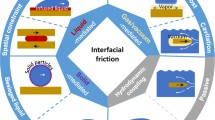Abstract
The flow of viscous liquid near the surface of rigid bodies is complex and depends on adhesive interactions that have been little studied.
Similar content being viewed by others
References
Vanchikov, V.Ts., Contact Forces, Priklad. Fiz., 2007, no. 3, pp. 40–45.
Vanchikov, V.Ts., Capillary Obliteration in Hydraulic Automation Systems, Vestn. Mashinostr., 2006, no. 1, p. 88.
Vanchikov, V.Ts., Upravlenie sloem treniya v technologicheskikh protsessakh (Control of the Frictional Layer in Technological Processes), Irkutsk: IrGUPS, 2006.
Vanchikov, V.Ts., Method of Determining the Cohesive forces in the Viscous Sublayer, Vestn. Mashinostr., 2007, no. 6, pp. 39–40.
Emtsov, B.T., Tekhnicheskaya gidromekhanika (Engineering Hydromechanics), Moscow: Mashinostroenie, 1978, p. 141.
Vanchikov, V.Ts., Microscopic Variation in Contact Systems, Vestn. Mashinostr., 2005, no. 8, pp. 32–33.
Author information
Authors and Affiliations
Additional information
Original Russian Text © V.Ts. Vanchikov, 2009, published in Vestnik Mashinostroeniya, 2009, No. 6, pp. 48–52.
About this article
Cite this article
Vanchikov, V.T. Liquid flow under adhesive forces. Russ. Engin. Res. 29, 575–578 (2009). https://doi.org/10.3103/S1068798X09060112
Published:
Issue Date:
DOI: https://doi.org/10.3103/S1068798X09060112




